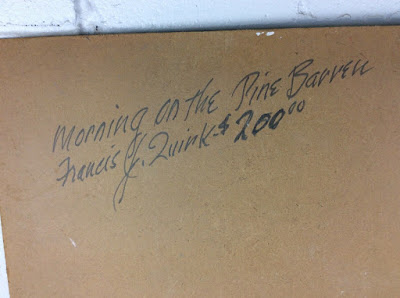'Morning on the Pine Barrens' was executed in 1970 when quirk was 63 years old. At this time in his life he had retired from teaching at Lehigh University and served as a Professor Emeritus. In 1969 he had spent a fellowship at Georgia's Ossabaw Island painting from nature.
The Pine Barrens, also known as the Pinelands or simply the Pines, is a heavily forested area of coastal plain stretching across more than seven counties of southern New Jersey. The name "pine barrens" refers to the area's sandy, acidic, nutrient-poor soil. Although European settlers could not cultivate their familiar crops there, the unique ecology of the Pine Barrens supports a diverse spectrum of plant life, including orchids and carnivorous plants. The area is also notable for its populations of rare pygmy pitch pines and other plant species that depend on the frequent fires of the Pine Barrens to reproduce. The sand that composes much of the area's soil is referred to by the locals as sugar sand.
 |
| Morning in the Pine Barrens by Francis J. Quirk |
The oil painting is painted on board, a material he frequently used. Parts of it including the trees on the left and right foreground as well as the forest wall seem almost monochromatic with a limited color palette. He executed several paintings from nature at Ossabaw that truly were monochromatic. Three prominent areas of color dominate this painting: the blue sky, yellow-green treetops and the green ground.
Focusing on the composition the line of treetops guides the eye to the middle right and then the two figures bring it back to the lower center. The hunters also are executed in a monochromatic fashion.
At first glance, it almost appears to be an unfinished work, but the price on the back indicates that it was sold as a finished work.
'Plein Air' is characterized as a style of painting out of the studio, outdoors with less adherence to academic rules. It originated in France along with impressionism in the 19th century. Special painting sets were developed that included mobile easels and cases for paint so that it was easier to get out into the countryside.
Popular plein air painters include John Constable and Alfred Sisley. An example from both is provided below. You can see that these paintings, like Quirk's, have a loose, less finished format. They capture the essence of the day without intense detail.
 |
| En Plein Air painting by Constable |
 |
| En Plein Air painting by Sisley |
Addendum- It has come to our attention that a person familiar with Francis Quirk's work questions the attribution of this painting to him. On the one hand it is less finished in appearance than most his work with monochromatic portions. This initially caused the author to raise an eyebrow. On the other hand Quirk was also producing truly monochromatic canvases at this time. And not every work by every painter is a masterpiece. Nonetheless, we felt that the nature of the question raised and the stature of the person raising it warranted sharing it with the readership.



No comments:
Post a Comment